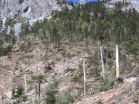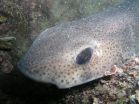(Press-News.org) Graphene is the miracle material of the future. Consisting of a single layer of carbon atoms arranged in a honeycomb lattice, the material is extremely stable, flexible, highly conductive and of particular interest for electronic applications. ETH Professor Tilman Esslinger and his group at the Institute for Quantum Electronics investigate artificial graphene; its honeycomb structure consists not of atoms, but rather of light. The researchers align multiple laser beams in such a way that they create standing waves with a hexagonal pattern. This optical lattice is then superimposed on potassium atoms in a vacuum chamber, which are cooled to near absolute zero temperature. Trapped in the hexagonal structure, the potassium atoms behave like the electrons in graphene.
"We work with atoms in laser beams because it provides us with a system that can be controlled better and observed more easily than the material itself," explains Gregor Jotzu, a doctoral student in Physics. Since the researchers focus primarily on understanding quantum mechanical interactions, they describe their system as a quantum simulator.
Thanks to this testing set-up, it has now become possible to implement an idea first published by the British physicist Duncan Haldane in 1988. Solid-state physicists had hoped they would be able to create the Haldane model with real graphene - in vain until now, says Esslinger: "Now we've done it with a different system. This is a beautiful and significant new step."
Breaking time-reversal symmetry
Haldane had suggested that it might be possible to create an entirely new class of materials with exceptional properties determined by their topology. Mathematically, objects have the same topology if they can be transformed into each other by continuous deformations, such as compression or stretching. For instance, an orange could be deformed into a banana. If the transformation requires a cut, then two objects are topologically distinct; for example, a Möbius strip can not be transformed into a normal strip without first cutting and then reassembling it.
In the Haldane model, the system no longer has the same topology as ordinary materials. Implementing this system requires a special 'ingredient' and physicists speak about breaking a symmetry: time-reversal symmetry is broken. This means that the system does not behave in the same manner when time runs backwards.
Normally, a physical system appears the same whether time moves forward or backwards; that is, this symmetry-breaking does not occur. Theoretically, this could be realised in real materials using magnetic fields. However, the magnets would have to be smaller and placed more precisely than the distance between atoms in a solid - less than about 0.1 nanometres.
"The particles experience a twisted world"
Using the quantum simulator, the researchers can break time-reversal symmetry with a relatively simple trick, as they have just reported in the journal Nature. "We shake the entire system in a circular motion," says Jotzu. The researchers placed small piezoelectric crystals on mirrors which reflect the laser light and then allowed them to vibrate. "It's even audible, roughly like a high flute tone," says the physicist. At the right frequency and amplitude, the atoms do not fall out of the laser lattice, as one might expect, but instead remain trapped.
When the researchers moved the system back and forth in a straight line, the atoms still behaved normally. But when shaken in a circular motion, "the particles experience a twisted world", explains Esslinger, just as the movement on a Möbius strip would differ from that on a normal one. The topology and hence the properties of the system changed as though it had become a completely different and new material.
Testing what does not yet exist
It was a surprise that they could implement the topological Haldane model experimentally, says the ETH professor; the experiment was "like shooting from the hip". The researchers celebrated their success fittingly with the right drink - shaken, not stirred. But Esslinger warns against drawing hasty conclusions: "We don't create new materials. We just tested a concept." In this context, experiments with lasers and ultracold atoms can be superior to computer simulations when a system is too complex for calculations. "This allows us to investigate the properties of materials that don't even exist yet," says Jotzu.
It is still uncertain if the results obtained with the quantum simulator could one day be transferred to real materials. But there are already ideas: If circularly-polarised light could be sent on to real graphene, it may have a similar effect as shaking artificial graphene in a circular motion. This was proposed by two visiting Japanese colleagues, says Esslinger. So it may be possible, for example, to make an insulator out of a conductive material using light - and vice versa. The electronic applications of such a system, which could react extremely fast, would be manifold.
INFORMATION:
The work at the Institute for Quantum Electronics was conducted within the Quantum Science and Technology (QSIT) research network. In addition to ETH Zurich, QSIT includes groups from the universities of Basel, Lausanne and Geneva, and IBM Research.
Literature reference
Jotzu G, Messer M, Desbuquois R, Lebrat M, Uehlinger T, Greif D, Esslinger T. Experimental realization of the topological Haldane model with ultracold fermions. 2014. Nature, published online 13 November. DOI: 10.1038/nature13915 [http://10.1038/nature13915]
A research team led by Jackson Laboratory Professors Frank McKeon, Ph.D., and Wa Xian, Ph.D., reports on the role of certain lung stem cells in regenerating lungs damaged by disease.
The work, published Nov. 12 in the journal Nature, sheds light on the inner workings of the still-emerging concept of lung regeneration and points to potential therapeutic strategies that harness these lung stem cells.
"The idea that the lung can regenerate has been slow to take hold in the biomedical research community," McKeon says, "in part because of the steady decline that is seen ...
The brain's ability to effectively deal with stress or to lack that ability and be more susceptible to depression, depends on a single protein type in each person's brain, according to a study conducted at the Icahn School of Medicine at Mount Sinai and published November 12 in the journal Nature.
The Mount Sinai study findings challenge the current thinking about depression and the drugs currently used to treat the disorder.
"Our findings are distinct from serotonin and other neurotransmitters previously implicated in depression or resilience against it," says the ...
Not long ago, it would have taken several years to run a high-resolution simulation on a global climate model. But using some of the most powerful supercomputers now available, Lawrence Berkeley National Laboratory (Berkeley Lab) climate scientist Michael Wehner was able to complete a run in just three months.
What he found was that not only were the simulations much closer to actual observations, but the high-resolution models were far better at reproducing intense storms, such as hurricanes and cyclones. The study, "The effect of horizontal resolution on simulation ...
The human immunodeficiency virus (HIV) can insert itself at different locations in the DNA of its human host - and this specific integration site determines how quickly the disease progresses, report researchers at KU Leuven's Laboratory for Molecular Virology and Gene Therapy. The study was published online today in the journal Cell Host & Microbe.
When HIV enters the bloodstream, virus particles bind to and invade human immune cells. HIV then reprogrammes the hijacked cell to make new HIV particles.
The HIV protein integrase plays a key role in this process: it ...
Details of the role of glutamate, the brain's excitatory chemical, in a drug reward pathway have been identified for the first time.
This discovery in rodents - published today in Nature Communications - shows that stimulation of glutamate neurons in a specific brain region (the dorsal raphe nucleus) leads to activation of dopamine-containing neurons in the brain's reward circuit (dopamine reward system).
Dopamine is a neurotransmitter present in regions of the brain that regulate movement, emotion, motivation, and feelings of pleasure. Glutamate is a neurotransmitter ...
HANOVER, N.H. - China's anti-logging, conservation and ecotourism policies are accelerating the loss of old-growth forests in one of the world's most ecologically fragile places, according to studies led by a Dartmouth College scientist.
The findings shed new light on the complex interactions between China's development and conservation policies and their impact on the most diverse temperate forests in the world, in "Shangri-La" in northwest Yunnan Province. Shangri-La, until recently an isolated Himalayan hinterland, is now the epicenter of China's struggle to wed sustainable ...
The "surfactant" chemicals found in samples of fracking fluid collected in five states were no more toxic than substances commonly found in homes, according to a first-of-its-kind analysis by researchers at the University of Colorado Boulder.
Fracking fluid is largely comprised of water and sand, but oil and gas companies also add a variety of other chemicals, including anti-bacterial agents, corrosion inhibitors and surfactants. Surfactants reduce the surface tension between water and oil, allowing for more oil to be extracted from porous rock underground.
In a new ...
Action movies may drive box office revenues, but dramas and deeper, more serious movies earn audience acclaim and appreciation, according to a team of researchers.
"Most people think that entertainment is just a silly diversion, but our research shows that entertainment is profoundly meaningful and moving for many people," said Mary Beth Oliver, Distinguished Professor in Media Studies and co-director of Media Effects Research Laboratory, Penn State. "It's not just types of entertainment that we usually think of as meaningful, such as poetry and dance, either, but also ...
Shark populations in the Mediterranean are highly divided, an international team of scientists, led by Dr Andrew Griffiths of the University of Bristol, has shown. Many previous studies on sharks suggest they move over large distances. But catsharks in the Mediterranean Sea appear to move and migrate much less, as revealed by this study. This could have important implications for conserving and managing sharks more widely, suggesting they may be more vulnerable to over-fishing than previously thought.
The study, published in the new journal Royal Society Open Science, ...
Providing health information on the internet may not be the "cure all" that it is hoped to be. It could sideline especially those Americans older than 65 years old who are not well versed in understanding health matters, and who do not use the web regularly. So says Helen Levy of the University of Michigan in the US, who led the first-ever study to show that elderly people's knowledge of health matters, so-called health literacy, also predicts how and if they use the internet. The findings¹ appear in the Journal of General Internal Medicine², published by Springer.
Substantial ...



